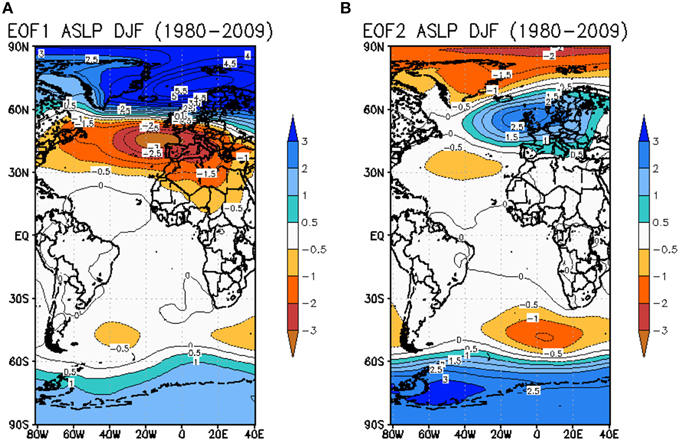The influence of extratropical Atlantic Ocean region on wet and dry years in North-Northeastern Brazil
- Center of Weather Forecasting and Climate Studies, National Institute of Space Research, São Paulo, Brazil
The rainy season of north-Northeastern Brazil (NE), one of the tropical regions with the largest rainfall interannual variability, is associated with the Intertropical Convergence Zone (ITCZ) influence, which is located in the southermost position during this season (March-April-May). However, there is a large interannual variability in the ITCZ position, associated with atmospheric and oceanic anomalies, responsible for dry or wet years in the region. Besides the tropical Pacific Sea Surface Temperature (SST) anomalies and the Tropical Atlantic SST gradient influences on this variability, extratropical atmospheric influences are identified over the North and South Atlantic. Composites of cases with anomalous precipitation during the middle of the rainy season (April) indicate the El Niño-Southern Oscillation (ENSO) features and northern and southern Atlantic atmospheric anomalies in December-January-February (DJF). When El Niño and La Niña years are removed from the composites of dry and wet cases, respectively, the centers of action over the extratropical North Atlantic in DJF remain, and features of extratropical South Hemisphere become more evident. The tropical SST dipole is still present with inverted signs in each case, consistent with the NE precipitation anomalies. The main mode of variability in the Southern Hemisphere (South Annular Mode) and in the Northern Hemisphere (North Annular Mode) is present in DJF during the dry cases. These annular patterns occur in the composites of Northeast Brazil precipitation anomalies including or excluding ENSO years. Therefore, besides ENSO relations with SAM discussed in previous studies, another connection exists over the South Atlantic, linking anomalies between high and tropical latitudes. The precipitation anomalies over NE have contributions of the two extratropical Atlantic hemispheres regions. The atmospheric anomalies observed in the pre-rainy season can be a helpful tool in monitoring the North Northeastern Brazil rainfall variability.
Introduction
The rainy season in the northern sector of Northeastern Brazil (NE) occurs in March-April-May (MAM), associated with the displacement of the Intertropical Convergence Zone (ITCZ) along the year, following the seasonal warm Sea Surface Temperature (SST) displacement north-south (Hastenrath, 1984). The ITCZ variability depends on the tropical inter-hemispheric Atlantic SST and atmospheric circulation mechanisms (Hastenrath and Heller, 1977; Moura and Shukla, 1981; Hastenrath and Greischar, 1993) and affects the NE rainfall. A review of impacts of the rainfall variability in this region was presented in Hastenrath (2012). Besides the tropical Atlantic, the Pacific Ocean has a strong influence on NE precipitation, in El Niño years (Covey and Hastenrath, 1978; Kousky et al., 1984). The changes in the Walker circulation with ascent motion in the eastern or central Pacific and subsidence over Northeast Brazil and Atlantic Ocean during El Niño, were discussed by Kousky et al. (1984), Pezzi and Cavalcanti (2001), Souza and Ambrizzi (2002), and Tedeschi et al. (2013). Enfield and Mayer (1997) showed a relation between the Pacific SST and Atlantic SST in ENSO years. On the other hand, the influence of Atlantic anomalies on the Pacific ENSO, through changes in the Walker circulation was shown by Rodríguez-Fonseca et al. (2009). Besides interannual climate variability, intraseasonal variability indicated by Madden and Julian Oscillation (MJO) affects NE precipitation, as shown in Kayano and Kousky (1999).
Influences of synoptic systems on a daily basis that cause heavy precipitation over Northeast Brazil have been discussed by Kouadio et al. (2012), who analyzed the influence of easterly waves, (Kousky, 1980), who identified squall lines, and Cavalcanti (2012), who reported specific events associated with easterly disturbances. Other synoptic system that can affect rainfall variability over north Northeast Brazil is the upper tropospheric cyclonic vortice (Kousky and Gan, 1981). These synoptic systems are affected by larger spatial and temporal scales of atmospheric and oceanic conditions.
Extratropical teleconnection influences, such as the Pacific North America (PNA) pattern on NE rainfall was discussed in Rao and Brito (1985) and Nobre and Shukla (1996). Extreme precipitation events over NE were also associated with middle latitude wavetrains from the North and South Hemispheres (Liebmann et al., 2011). Extratropical features in December-January-February (DJF) associated with the shifting of the North Atlantic Oscillation (NAO) centers are connected to the ITCZ position in April (Souza and Cavalcanti, 2009). When the ITCZ is displaced southward, there are two anomalous centers of Sea Level Pressure (SLP) or geopotential at middle levels over extratropical North Atlantic, which are related to the shifting of the positive phase of NAO centers of action. In this way, the subtropical North Atlantic High is enhanced, intensifying the northerlies trade winds and pushing the convergence zone southwards. At the same time, the SST in the tropical North Atlantic is colder than normal, consistent with the stronger than normal trade winds and the atmospheric circulation at low levels. When the ITCZ is displaced northwards of the climatological position, the tropical SST and extratropical atmospheric anomalies display opposite conditions.
In the present study, wet and dry cases over northern NE, in April, are selected to analyze the atmospheric extratropical features in the Atlantic region more extensively, extending the area to the Pacific Ocean and removing the ENSO effects in order to identify other features associated with the NE precipitation.
Data and Method
The period of analysis is 1980–2009, accomplishing 30 years of climatology. Monthly precipitation data was obtained from the Global Precipitation Climatology Project (GPCP), (Adler et al., 2003) with horizontal resolution of 2.50 × 2.50. Monthly SST with horizontal resolution of 20 × 20, from Extended Reconstructed Sea Surface Temperature (ERSST), (Smith et al., 2008), and monthly atmospheric data from ERA–Interim reanalyses with horizontal resolution of 1.50 × 1.50 (Dee et al., 2011) were used to analyze the large scale features.
The area of analysis is the northern of Northeast Brazil (NE). Wet and dry cases over NE in April are selected using the Standardized Precipitation Index (SPI) proposed by McKee et al. (1993), applied to the spatial average of precipitation anomalies in the area (460W− 350W; 60S− 20S). The index identifies extreme wet/dry (SPI ≥ 2.0/SPI ≤ −2.0), severe wet/dry (1.5 ≤ SPI ≤ 2.0)/− 2 < SPI ≤ −1.5), and moderate wet/dry (1.0 ≤ SPI < 1.5)/(− 1.5 < SPI ≤ −1.0) conditions. Another category was introduced to identify weak wet and dry cases (0.5 < SPI < 1.0/− 1.0 < SPI < −0.5) that affect also the region. The index is obtained dividing the precipitation anomaly by the standard deviation. The anomalies were calculated considering the climatological period of 1980–2009. Composites of wet and dry selected cases and new sets without ENSO years are analyzed to identify other features. ENSO years were obtained from CPC/NOAA MAM conditions. The students test was applied to precipitation composites to show the significance of each wet and dry cases. Precipitation and SST anomalies of April, and atmospheric fields of DJF are analyzed for the composites. An Empirical Orthogonal Function (EOF) analysis is applied to SLP anomalies over the Atlantic Ocean to discuss the relations between the main modes of interannual variability and the precipitation anomalies over NE.
The evolution of the tropical Atlantic SST dipole defined as the difference between the tropical North Atlantic (200N–100N; 500W–200W) and tropical South Atlantic (00–100S; 300W–100W) anomalous SST is compared to the evolution of NE SPI during the analyzed period. The precipitation variability in NE is also compared to the timeseries of the Principal Component coefficients associated with the second mode of Atlantic SLP variability. Correlations of NAI index defined in Souza and Cavalcanti (2009) as the normalized SLP anomaly difference at two points, P1: 350N; 400W and P2: 500N; 100W, with SLP anomalies in all grid points, reinforce some aspects of extratropical influences. Correlations of SLP in the anomalous center close to South Africa (500S; 50E), identified in Souza and Cavalcanti (2009), with other gridpoints are analyzed to investigate extratropical connections. Timeseries of anomalous pressure over extratropical South Atlantic are compared to NE SPI.
Composites of Wet and Dry NE. Precipitation and Atmospheric/Oceanic Anomalies
In Table 1 and timeseries of SPI for April (Figure 1, blue line) it is seen that there are not cases in the extreme category. There are two wet and dry severe cases, four moderate wet cases, five moderate dry cases, four wet weak cases, and three dry weak cases. Although there is one severe wet case in the 80's and one in the first decade of the twenty-first century, there are more dry cases in the first decade than in the last decade. This finding could suggest a relation to trends in the tropical Atlantic SST. However, the timeseries of SST dipole, in Figure 1 (black line), does not show such trend. A longer timeseries should be analyzed to explore the trends in the Atlantic and Pacific that could be related to trends in NE precipitation, which is out of the present study objective. An inspection in the precipitation anomalies of all individual cases shows that they present similar influences of the ITCZ displacement. Therefore, a composite analysis was performed with 10 cases in each category (Figure 2). The influence of ITCZ is very clear in the composites. Although the ITCZ develops over the ocean, the strongest precipitation anomalies occur over the extreme northern sector of NE and anomalies extend to eastern Amazonia, in both wet and dry cases. At the same time, opposite anomalies occur over northern South America and in part of southeastern South America. The opposite conditions in the north are associated with the displacement of the ITCZ southwards in the wet NE and northwards in the dry NE. The opposite sign in the southern region is likely to be associated with wavetrains from the Pacific Ocean and moisture flux anomalies from the Amazon region. Anomalies in the Indonesia and Pacific region can trigger Rossby wavetrains identified in several studies of precipitation and convection anomalies over South America, such as Mo and Higgins (1998), Mo and Paegle (2001), Cunningham and Cavalcanti (2006) among others. Precipitation anomalies over La Plata basin have been also related to moisture flux from tropical regions of South America (Drumond et al., 2008). While this latter mechanism can be related directly to precipitation anomalies in the tropical South America, the former connection with the ITCZ behavior needs further investigation, which is out of the present study scope.
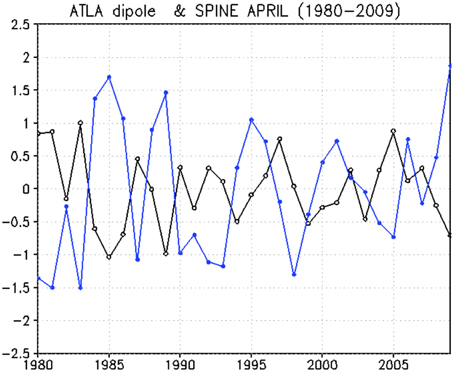
Figure 1. SPI time series in north-Northeastern Brazil (460W–350W; 60S–20S) (blue line) and timeseries of SST dipole, defined as the difference between the tropical North Atlantic (200N–100N; 500W–200W) and tropical South Atlantic (00–100S; 300W–100W) anomalous SST (0C) in April.
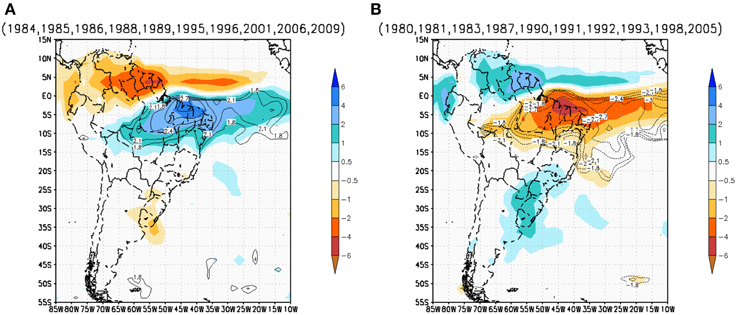
Figure 2. Precipitation anomaly composites (mm/day) [shading] of (A) wet and (B) dry April years in north-Northeastern Brazil. Contour lines above 1.8 (wet) and below −1.8 (dry) indicate regions in NE with significance of 95%.
The SLP anomalies composites in DJF for wet and dry cases display the North Atlantic extratropical high-low dipole, with opposite signs in each category (Figure 3, contour), similar to that found in Souza and Cavalcanti (2009) in cases of the ITCZ displacement. In the wet composite, the anomalous high pressure over the North Atlantic indicates its influence on the southward shifting of the ITCZ, and also on the establishment of cold waters in the tropical North Atlantic. At the same time there is low pressure over the South Atlantic Ocean, which favors the positive SST anomalies in the tropical South Atlantic region. In the dry composite, the anomalous low pressure center over the North Atlantic is consistent with the northward ITCZ displacement and warm waters in the tropical North Atlantic. SST anomalies in April (Figure 3, shaded), display the Tropical Atlantic dipole or SST north-south gradient, which is typical of the ITCZ displacement (Hastenrath and Greischar, 1993; Nobre and Shukla, 1996). The presence of the Atlantic extratropical atmospheric anomalies is consistent with the SST anomalies.
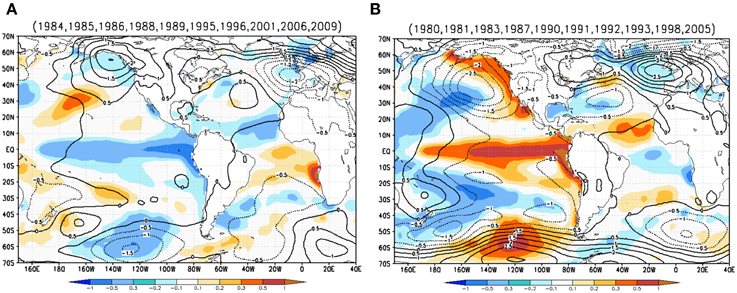
Figure 3. SST anomaly in April (0C) [shading] and SLP anomaly in DJF (hPa) [contour] (A) wet cases; (B) dry cases.
The extratropical high-low pressure dipole in the dry and wet composites is related to the second mode of variability over the Atlantic Ocean, resulting from an EOF analysis of SLP, as seen in Figure 4B. The SLP main mode of variability in DJF over the Atlantic Ocean is the NAO, seen in Figure 4A. It was suggested, in Souza and Cavalcanti (2009) that the two extratropical centers of action associated with the displacement of the ITCZ represented the shifting of the NAO centers. This shifting can produce climate anomalies also over western Europe, with anomalous high or low pressure, as seen in Figure 3. Among others, the role of NAO on precipitation over Europe has been discussed by Trigo et al. (2002), focusing on the Iberian Peninsula, and by Uvo (2003), on Norway, Sweden and Finland. Shifting of NAO centers was analyzed by Vicente-Serrano and López-Moreno (2008) in interdecadal scale, showing influences over Europe. Figure 3 shows that low (high) pressure anomaly would favor wet (dry) conditions in western Europe, during DJF. The relation between anomalous precipitation in NE and the second mode of SLP is shown in Table 2 and Figure 5. For example, the severe dry year of 1980 (negative SPI) has positive PC, which indicates negative SLP anomaly at the southern center of extratropical high-low dipole over North Atlantic. On the other hand, the severe wet year of 2009 has negative PC, which point to positive anomaly in that center. All dry years, selected by SPI, except 1998, have positive principal component coefficients of second mode (PC2) that indicate the desintensification of the North Atlantic Subtropical High, which is consistent with the ITCZ displaced northwards. The SST dipole is also positive, except in 1991, which indicates warmer tropical North Atlantic that favors the northward ITCZ displacement (Table 2). The relation between the PC2 and SPI for wet cases does not occur every year, and the SST dipole favorable to southward ITCZ displacement occurs in 7 out of 10 years. In the next section, the influence of the extratropical South Atlantic region on NE precipitation is discussed to show its complementary contribution for NE precipitation variability.

Table 2. Signs of: Principal component coefficients of mode 2 (PC2), SST dipole, defined as the difference between the tropical North Atlantic (200N–100N; 500W–200W) and tropical South Atlantic (00S–100S; 300W–100W) anomalous SST, anomalous SLP at 400W; 600S (ASLP ATLSUL).
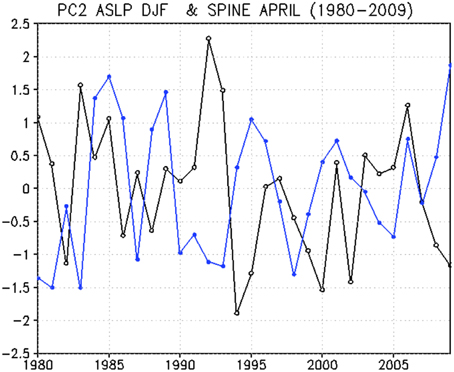
Figure 5. Timeseries of Principal Component Coefficient of the second mode of SLP variability represented in Figure 4 (black line) and timeseries of NE SPI (blue line).
Besides the two centers of action over the extratropical North Atlantic Ocean, an anomalous SLP center near the west coast of North America changes sign from wet to dry cases, being located at the same region of the northern center of the Pacific Decadal Oscillation (PDO). Influences of PDO on South America precipitation, including NE region were discussed in Kayano and Andreoli (2007). The combined effect of ENSO and PDO has impacts on South America. Andreoli and Kayano (2005) showed the circulation changes in cases of ENSO and PDO and their influences over South America. They mention the existence of divergence at high levels in the tropical region, Rossby wavetrains in both hemispheres, changes in the subtropical jet stream and in the Walker and Hadley cells. In the extratropical South Hemisphere, the alternating SLP anomalies over South Pacific also change signs, as well as the center to the south of South Africa, in the wet and dry composites (Figures 3A,B).
Composites without ENSO Years
As the composites include ENSO years, its signature is seen in the anomalous SST composites (Figure 3, shading). There are La Niña conditions (cold anomalies in Eastern equatorial Pacific) in wet cases, and El Niño conditions (warm anomalies) in dry cases. These characteristics are expected, since the NE precipitation is affected by ENSO, as seen in several studies (e.g., Covey and Hastenrath, 1978; Kousky et al., 1984; Kayano et al., 1988; Kayano and Andreoli, 2006; Tedeschi et al., 2013). Therefore, to remove the ENSO influence, the wet composites were divided in groups of La Niña years and without La Niña years and the dry composites were divided in groups of El Niño years and without El Niño years. Table 3 indicates El Niño and La Niña years.
Figure 6 shows the precipitation anomaly composites of six neutral ENSO years in each category (indicated in bold in Table 2). The same features observed in the total composites are identified, indicating that other mechanisms responsible for the precipitation anomalies are still present. The SST Tropical Atlantic dipole is still present in both wet and dry composites without ENSO years and also consistent with the ITCZ influence on NE precipitation. The wet composite without La Niña still shows colder than normal waters in the eastern equatorial Pacific (Figure 7A), but in the dry cases there are also cold anomalies in this region (Figure 7B). Analyzing year-by-year, negative SST anomalies close to western South America occurred, although weaker, in April of some years of wet or dry composites. Even excluding ENSO years, western and extratropical Pacific SST anomaly configuration display opposite signs in wet and dry NE, but extratropical atmospheric patterns over the North Pacific are very different. The SST composites of wet and dry cases, in the Pacific Ocean, display opposite SST anomalies at equatorial data line and a boomerang-shape pattern, also with opposite anomalies. Tedeschi et al. (2013) identified boomerang patterns in ENSO composites and discussed their extratropical influences on atmospheric circulation with impacts on South America precipitation. It is seen in the present study that these patterns happen also in neutral ENSO years. Opposite SST anomalies in each composite are seen also close to western North America and southern South Pacific. A connection of these opposite SST anomalies in the Pacific with atmospheric circulation and effects on NE precipitation in non-ENSO years is still a subject of investigation.
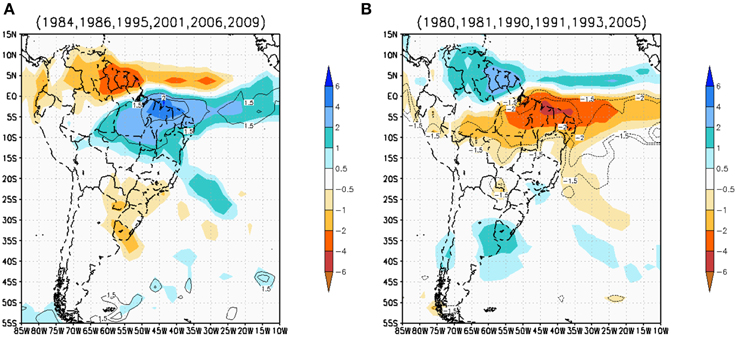
Figure 6. Precipitation anomaly composites (mm/day) [shading] of (A) wet and (B) dry years in north-Northeastern Brazil, excluding ENSO years. Contour lines above 1.5 (wet) and below −1.5 (dry) indicate regions in NE with significance of 95%.
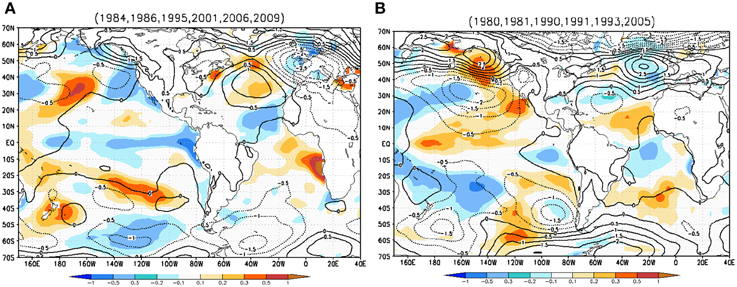
Figure 7. SST anomaly in April (°C) [shading] and SLP anomaly in DJF (hPa) [contour] excluding ENSO years (A) wet cases; (B) dry cases.
The two North Atlantic extratropical anomalous centers of opposite signs remain in the wet and dry composites, consistent with the tropical North Atlantic SST anomalies, after removing the effect of ENSO (Figure 7). In April 2009, heavy precipitation and flooding occurred in several areas of Northeast, and these anomalous North Atlantic extratropical centers were identified, as shown in Cavalcanti (2012). In the SLP anomalous composites, the pattern changes over the Pacific close to the western coast of North America compared to the total composites. In both wet and dry composites there is a north-south dipole of high-low pressure, indicating that it does not have relation with NE precipitation anomalies (Figure 7). Over the extratropical South Pacific and South Atlantic, opposite anomalies are identified in the wet and dry composites, which may act as forcing of changes in the tropical South Atlantic atmospheric circulation.
The centers of action over the North Atlantic are identified also in the geopotential at 500 hPa level (Figure 8). In the wet composite they are part of a wave number three configuration in the Northern Hemisphere, identified by the troughs and ridges. In the dry composite, the positive phase of the North Annular Mode (NAM) can be recognized, with negative geopotencial anomalies over the polar region and opposite anomalies at middle latitudes. In the Southern Hemisphere (Figure 9), the dry composite of geopotencial anomalies at 500 hPa displays the negative phase of the Southern Annular Mode (SAM), with positive anomalies over the polar region and negative anomalies at middle latitudes. In the wet composite a wavenumber one is evident at middle and high latitudes. Therefore, in the dry case, the NAM and SAM in opposite phases seems to be extratropical forcings influencing tropical features. It is suggested that the intensification of the North Polar Vortex (positive NAM phase and associated lower pressure) and desintensification of the South Polar Vortex (negative SAM phase and associated higher pressure) could affect the tropical atmospheric circulation by changes in the Atlantic Subtropical Highs and in the trade winds.
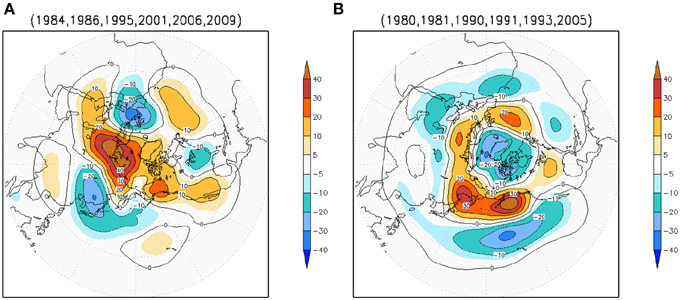
Figure 8. Geopotential anomaly in DJF, N.H., at 500 hPa (mgp) excluding ENSO years (A) wet cases, (B) dry cases.
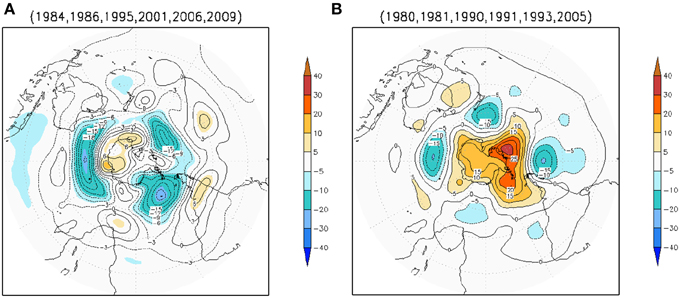
Figure 9. Geopotential anomaly in DJF, S.H., at 500 hPa (mgp) excluding ENSO years (A) wet cases, (B) dry cases.
Centers of Action Over the Extratropical North and South Atlantic Oceans
Correlations of the NAI index with SLP anomalies in all grid points, show the two centers of action over the North Atlantic and opposite anomalies at high latitudes of the North and South Hemispheres, besides features of the Southern Oscillation (Figure 10A). The correlation of anomalous center close to South Africa (500S; 50E), identified in Souza and Cavalcanti (2009) and also shown in the second mode of SLP variability (Figure 4B), with the other grid points, indicate relations of SAM, ENSO features and tropical Atlantic (Figure 10B). The relation between ENSO and the Antarctic Oscillation or SAM has been identified and discussed in several studies, such as Carvalho et al. (2005), L'Heureux and Thompson (2006), Fogt et al. (2012). Opposite correlations between eastern equatorial Pacific and equatorial Atlantic regions, seen in Figure 10B, are related to the ENSO influences, as discussed in Covey and Hastenrath (1978). The connection of the SAM with tropical South Atlantic is also seen in Figure 11, which shows correlations of the South Atlantic SLP average (350W–00) between 500 S and latitudes from the Southern Pole to the equator. The same sign at high and tropical latitudes and opposite signs at middle latitudes seen in Figure 11, were discussed by Mo and White (1985), who showed correlations of zonally averaged anomalies of SLP at 500S with other latitudes, in the austral wintertime. Here, the same connections occur in the austral summer time, however only for the Atlantic sector.
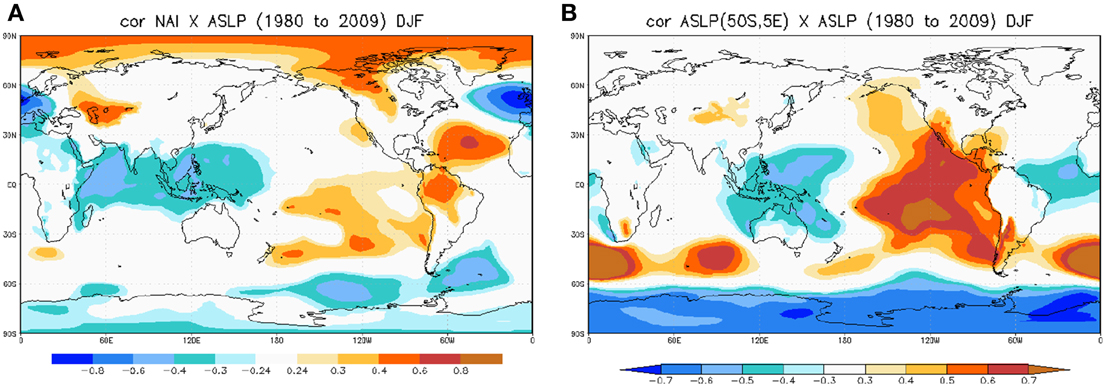
Figure 10. (A) Correlations of NAI with SLP with significance levels of 90% (above 0.24) and 95% (above 0.3), (B) correlations of SLP at 500S; 50E with other gridpoints, with significance of 95% above 0.3.
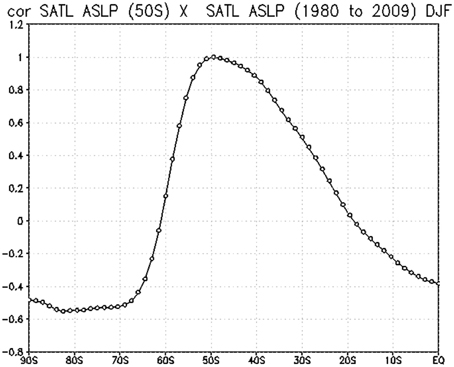
Figure 11. Correlation of South Atlantic SLP average (350W–00) between 500 S and latitudes from the Southern Pole to the equator.
To investigate the role of the extratropical South Atlantic region on the NE precipitation, the variability of anomalous pressure at (400W; 600S), identified as a center with opposite signs in Figure 7, is analyzed in Table 2 and Figure 12. The composites show anomalous low pressure for wet cases and anomalous high pressure for dry cases over extratropical Pacific and Atlantic close to South America. Four out of the six cases without El Niño (without La Niña) presented positive (negative) anomaly in this center. In the other two dry cases, the North Atlantic centers of action were favorable (PC2 +). In the other two wet cases that presented positive anomalous SLP in the extratropical South Atlantic, one had influence of the North Atlantic PC2 (1995) and in 2006 the two indices and also the SST dipole were unfavorable to anomalous NE rainfall. This year was selected as weak wet in the SPI category, and other features could be responsible for the anomalous precipitation, like the easterly disturbances or the high level cyclonic vortex position, discussed in the introduction.
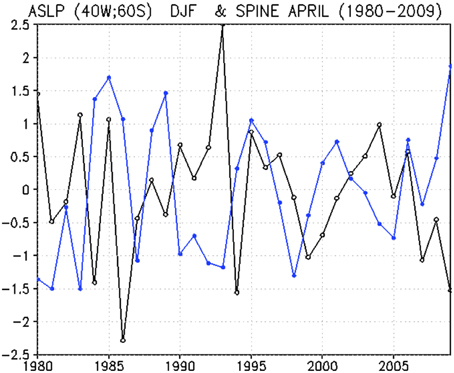
Figure 12. Timeseries of anomalous SLP at 400W; 600S (black line) and timeseries of NE SPI (blue line).
Conclusion
Composites of wet and dry cases over northern Northeast Brazil (NE) indicated that besides ENSO influences, there are extratropical Atlantic anomalies, which affect the precipitation variability of this region. Removing the ENSO influence, both Atlantic hemispheres contribute to the precipitation anomalies over NE. The extratropical centers of action, displayed by the second mode of North Atlantic atmospheric variability, have strong influences on the ITCZ and NE precipitation. The high (low) pressure anomalies of the southern center affect the tropical SST and trade winds, which result in ITCZ shiftings and wet (dry) cases over NE. High latitude anomalies over the South Atlantic affect also the tropical features of atmosphere and ocean. Low (high) pressure anomalies occur over extratropical South Atlantic in wet (dry) cases. The combined influence of both extratropical hemispheres contributes to the strong precipitation anomalies over northern NE region.
The SAM centers, which represent the dominant Southern Hemisphere mode of variability, have connections with the tropical Atlantic and seem to affect also the conditions for ITCZ displacement. When NAM and SAM are well-characterized and in opposite phases, an anomalous high pressure dominates high latitudes of the Southern Hemisphere at the same time that anomalous low pressure dominates high latitudes of the Northern Hemisphere in the Atlantic. These anomalous atmospheric conditions seem to influence NE precipitation variability particularly during non-ENSO years. Additional analyses are necessary to further understand the inter-hemispheric extratropical influence on convection in the ITCZ and precipitation over NE. However, observed anomalies over extratropical North and South Atlantic in DJF could be used in monitoring rainfall during the peak of the rainy season over Northeastern Brazil.
Conflict of Interest Statement
The author declares that the research was conducted in the absence of any commercial or financial relationships that could be construed as a potential conflict of interest.
Acknowledgments
To CNPq (Brazil) for the research funding. The GPCP combined precipitation data were provided by the NASA/Goddard Space Flight Center's Laboratory for Atmospheres, which develops and computes the dataset as a contribution to the GEWEX Global Precipitation Climatology Project. Era Interim is provided by the European Centre for Medium-Range Weather Forecasts (ECMWF).
References
Adler, R. F., Huffman, G. J., Chang, A., Ferraro, R., Xie, P., Janowiak, J., et al. (2003). The version 2 Global Precipitation Climatology Project (GPCP) monthly precipitation analysis (1979-Present). J. Hydrometeorol. 4, 1147–1167. doi: 10.1175/1525-7541(2003)004<1147:TVGPCP>2.0.CO;2
Andreoli, R. V., and Kayano, M. T. (2005). ENSO-related rainfall anomalies in South America and associated circulation features during warm and cold Pacific decadal oscillation regimes. Int. J. Climatol. 25, 2017–2030. doi: 10.1002/joc.1222
Carvalho, L. M. V., Jones, C., and Ambrizzi, T. (2005). Opposite phases of the Antarctic Oscillation and relationships with intraseasonal to interannual activity in the tropics during the austral summer. J. Clim. 18, 702–718. doi: 10.1175/JCLI-3284.1
Cavalcanti, I. F. A. (2012). Large scale and synoptic features associated with extreme precipitation over South America: a review and case studies for the first decade of the 21st century. Atmos. Res. 118, 27–40. doi: 10.1016/j.atmosres.2012.06.012
Covey, D. L., and Hastenrath, S. (1978). The Pacific El Niño phenomenon and the Atlantic circulation. Mon. Weather Rev. 108, 1280–1287.
Cunningham, C. A. C., and Cavalcanti, I. F. A. (2006). Intraseasonal modes of variability affecting the South Atlantic Convergence Zone. Int. J. Climatol. 26, 1165–1180. doi: 10.1002/joc.1309
Dee, D. P., Uppala, S. M., Simmons, A. J., Berrisford, P., Poli, P., Kobayashi, S., et al. (2011). The ERA-Interim reanalysis: configuration and performance of the data assimilation system. Q. J. R. Meteorol. Soc. 137, 553–597. doi: 10.1002/qj.828
Drumond, A., Nieto, R., Gimeno, L., and Ambrizzi, T. (2008). A lagrangian identification of major sources of moisture over Central Brazil and La Plata Basin. J. Geophys. Res. 113, D14128. doi: 10.1029/2007JD009547
Enfield, D. B., and Mayer, D. A. (1997). Tropical Atlantic sea surface temperature variability and its relation to El Niño-Southern Oscillation. J. Geophys. Res. 102, 929–945. doi: 10.1029/96JC03296
Fogt, R. L., Jones, J. M., and Renwick, J. (2012). Seasonal zonal asymmetries in the Southern Annular Mode and their impact on regional temperature anomalies. J. Clim. 25, 6253–6270. doi: 10.1175/JCLI-D-11-00474.1
Hastenrath, S. (1984). Interannual variability and annual cycle: mechanisms of circulation and climate in the Tropical Atlantic sector. Mon. Weather Rev. 112, 1097–1107.
Hastenrath, S. (2012). Exploring the climate problems of Brazil's Nordeste: a review. Clim. Change 112, 243–251. doi: 10.1007/s10584-011-0227-1
Hastenrath, S., and Greischar, L. (1993). Further work on the prediction of Northeast Brazil rainfall anomalies. J. Clim. 6, 743–758.
Hastenrath, S., and Heller, L. (1977). Dynamics of climatic hazards in northeast Brazil. Q. J. R. Meteorol. Soc. 103, 77–92. doi: 10.1002/qj.49710343505
Kayano, M. T., and Kousky, V. E. (1999). Intraseasonal (30–60 day) variability in the global tropics: principal modes and their evolution. Tellus A 51, 373–386. doi: 10.1034/j.1600-0870.1999.t01-3-00003.x
Kayano, M. T., Rao, V. B., and Moura, A. D. (1988). Tropical circulations and the associated rainfall anomalies during two contrasting years. J. Climatol. 8, 477–488. doi: 10.1002/joc.3370080504
Kayano, M. T., and Andreoli, R. V. (2006). Relationships between rainfall anomalies over northeastern Brazil and the El Niño–Southern Oscillation. J. Geophys. Res. 111. D13101. doi: 10.1029/2005JD006142
Kayano, M. T., and Andreoli, R. V. (2007). Relations of South American summer rainfall interannual variations with the Pacific Decadal Oscillation. Int. J. Climatol. 27, 531–540. doi: 10.1002/joc.1417
Kouadio, Y. K., Servain, J., Machado, L. A. T., and Lentini, C. A. D. (2012). Heavy rainfall episodes in the eastern Northeast Brazil linked to large-scale ocean-atmosphere conditions in the Tropical Atlantic. Adv. Meteorol. 2012:369567. doi: 10.1155/2012/369567
Kousky, V. E. (1980). Diurnal rainfall variation in Northeast Brazil. Mon. Weather Rev. 108, 488–498.
Kousky, V. E., Kayano, M. T., and Cavalcanti, I. F. A. (1984). A review of the Southern Oscillation: oceanic-atmospheric circulation changes and related rainfall anomalies. Tellus 36A, 490–504. doi: 10.1111/j.1600-0870.1984.tb00264.x
Kousky, V. E., and Gan, M. A. (1981). Upper tropospheric cyclonic vortices in the tropical South Atlantic. Tellus 33, 538–551. doi: 10.1111/j.2153-3490.1981.tb01780.x
L'Heureux, M. L., and Thompson, D. W. J. (2006). Observed relationships between the El Niño-Southern Oscillation and the extratropical zonal-mean circulation. J. Clim. 19, 276–287. doi: 10.1175/JCLI3617.1
Liebmann, B., Kiladis, G. N., Allured, D., Vera, C. S., Jones, C., Carvalho, L. M. V., et al. (2011). Mechanisms associated with large daily rainfall events in Northeast Brazil. J. Clim. 24, 376–396. doi: 10.1175/2010JCLI3457.1
McKee, B., Doesken, N. J., and Kleist, J. (1993). “The Relationship of drought frequency and duration to time scales,” in Proceedings of the 8th Conference on Applied Climatology (Anaheim, CA), 179–184.
Mo, K. C., and Higgins, R. W. (1998). The Pacific-South American modes and tropical convection during the Southern Hemisphere winter. Mon. Weather Rev. 126, 1581–1596.
Mo, K. C., and Paegle, J. N. (2001). The Pacific-South American modes and their downstream effects. Int. J. Climatol. 21, 1211–1229. doi: 10.1002/joc.685
Mo, K. C., and White, G. H. (1985). Teleconnections in the Southern Hemisphere. Mon. Weather Rev. 113, 22–37.
Moura, A. D., and Shukla, J. (1981). On the dynamics of droughts in Northeast Brazil: observations, theory, and numerical experiments with a general circulation model. J. Atmos. Sci. 38, 2653–2675.
Nobre, P., and Shukla, J. (1996). Variations of sea surface temperature, wind stress and rainfall over the Tropical Atlantic and South America. J. Clim. 9, 2464–2479.
Pezzi, L. P., and Cavalcanti, I. F. A. (2001). The relative importance of ENSO and Tropical Atlantic sea surface temperature anomalies for seasonal precipitation over South America. Clim. Dyn. 17, 205–212. doi: 10.1007/s003820000104
Rao, V. B., and Brito, J. I. B. (1985). Teleconnections between the rainfall over Northeast Brazil and the winter circulation of Northern Hemisphere. Pure Appl. Geophys. 123, 951–959. doi: 10.1007/BF00876982
Rodríguez-Fonseca, B., Polo, I., García-Serrano, J., Losada, T., Mohino, E., Mechoso, C. R., et al. (2009). Are Atlantic Niños enhancing Pacific ENSO events in recent decades? Geophys. Res. Lett. 36, L20705. doi: 10.1029/2009GL040048
Smith, T. M., Reynolds, R. W., Peterson, T. C., and Lawrimore, J. (2008). Improvements to NOAAs historical merged land–ocean temperature analysis (1880–2006). J. Clim. 21, 2283–2296. doi: 10.1175/2007JCLI2100.1
Souza, E. B., and Ambrizzi, T. (2002). ENSO impacts on the South American rainfall during 1980s: Hadley and Walker circulation. Atmósfera 15, 105–120.
Souza, P., and Cavalcanti, I. F. A. (2009). Atmospheric centres of action associated with the Atlantic ITCZ position. Int. J. Climatol. 29, 2091–2105. doi: 10.1002/joc.1823
Tedeschi, R. G., Cavalcanti, I. F. A., and Grimm, A. M. (2013). Influences of two types of ENSO on South American precipitation. Int. J. Climatol. 33, 1382–1400. doi: 10.1002/joc.3519
Trigo, R. M., Osborn, T. J., and Corte-Real, J. (2002). The North Atlantic oscillation influence on Europe: climate impacts and associated physical mechanisms. Clim. Res. 20, 9–17. doi: 10.3354/cr020009
Uvo, C. B. (2003). Analysis and regionalization of northern European winter precipitation based on its relationship with the North Atlantic oscillation. Int. J. Climatol. 23, 1185–1194. doi: 10.1002/joc.930
Keywords: Northeast Brazil, Atlantic Ocean, ITCZ, precipitation anomalies, North Atlantic centers of action
Citation: de Albuquerque Cavalcanti IF (2015) The influence of extratropical Atlantic Ocean region on wet and dry years in North-Northeastern Brazil. Front. Environ. Sci. 3:34. doi: 10.3389/fenvs.2015.00034
Received: 11 November 2014; Accepted: 16 April 2015;
Published: 30 April 2015.
Edited by:
Anita Drumond, University of Vigo, SpainReviewed by:
Everaldo Barreiros De Souza, Universidade Federal do Para, BrazilLeila Vespoli Carvalho, University of California, Santa Barbara, USA
Copyright © 2015 de Albuquerque Cavalcanti. This is an open-access article distributed under the terms of the Creative Commons Attribution License (CC BY). The use, distribution or reproduction in other forums is permitted, provided the original author(s) or licensor are credited and that the original publication in this journal is cited, in accordance with accepted academic practice. No use, distribution or reproduction is permitted which does not comply with these terms.
*Correspondence: Iracema F. de Albuquerque Cavalcanti, Center of Weather Forecasting and Climate Studies, National Institute of Space Research, Rodovia Presidente Dutra, km 40, CEP 12630-000, São Paulo, Brazil, iracema.cavalcanti@cptec.inpe.br
 Iracema F. de Albuquerque Cavalcanti
Iracema F. de Albuquerque Cavalcanti
